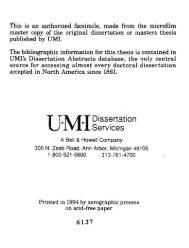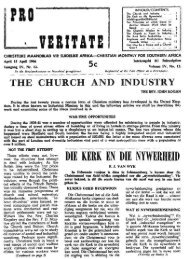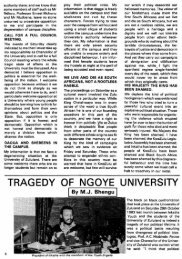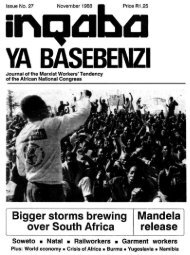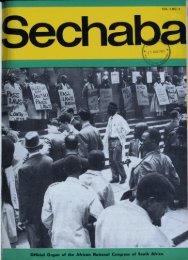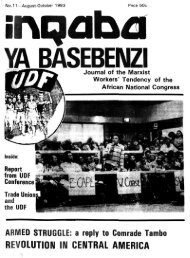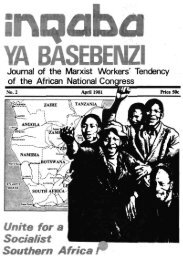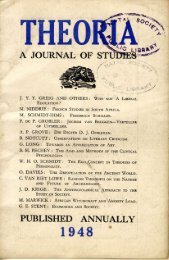Create successful ePaper yourself
Turn your PDF publications into a flip-book with our unique Google optimized e-Paper software.
page 3<br />
Koranic aspect of this boom was that It lad to e<br />
dramatic concentration «nd centrelieation of capital<br />
on the basis of cv*r more capital inteneive production,<br />
leading to significant shifts in relatione within the<br />
capitalist class. Prior to the 1960s, South African<br />
industry was characterised by a sharp economic<br />
distinction and political antagonist between local<br />
undertakings and foreign capital. "•> & 00 * 9 f ^ha<br />
i9€Oa produced the rapid intervenetratIon of capitals<br />
and the consolidation of the dominance of diversified<br />
monopolies within the economy generally, and in all<br />
the major sectors of capitalist production. This<br />
process was effect^ on the basis of a_ massive influx<br />
of foreign capital, in a country where the return on<br />
capital was amongst the highest in the world. By<br />
1970. total foreign investment was estimated at<br />
R5 81&-milllon, and a total of R3 559-million foreign<br />
investment capital flowed into South Africa in the<br />
period 196S - 19?o\ 6<br />
Consequent on this Increasing dominance of<br />
capital-intensive production, these years further saw<br />
significant changes in the organisation of the<br />
proletariat within production, accelerating the process<br />
of the simultaneous attraction and extrusion of workers<br />
from production. The introduction of Increasingly<br />
sophisticated technology into the production process<br />
on an ever expanding scale, leads to a relative<br />
reduction in the number of workers needed to operate<br />
it. moreover, it simultaneously Introduces a new<br />
industrial division of labour between semi-skilled<br />
operatives on the one hand, and technical/supervisory<br />
labour on the other, replacing the old unskilled/<br />
skilled division of labour. Thus, during this period,<br />
whilst large numbers of sami-skilled operatives were<br />
being drawn into production, even lerger numbers of<br />
unskilled african migrant workers lost their Jobs as<br />
they became 'redundant 1 . Throughout the 'boom',<br />
african unemployment stood at over 1 million. The<br />
Influx control measures and pass laws of the apartheid<br />
system operated to expel the unemployed from the<br />
cities end dump and barricade them In the festering<br />
rural slums of bantustano. This process marked a<br />
decisive shift aw«y from the reliance on cheep,<br />
unakillad migrant labour so long charactar 1 Stic of<br />
South African industry, towards the consolidation of<br />
a stable, ssml-ekllled workforce.<br />
Similarly during this period, large numbers of<br />
skilled (white) workers eere also rendered relatival/<br />
superfluous to capital Intensive production, as their<br />
skills were superceded by the need for technical/<br />
supervisory labour. Yet in apartheid South Africe.<br />
the Jobs of white workers were protected. The rigid<br />
industrial colour bar reserved all supervisory,<br />
technical and professional work for whites. Thus in<br />
this changing organisation of the labour process, few<br />
shite workers lost their Jobs, but were either<br />
retrained and/or converted into supervisors of efrican<br />
workers. However, this process of reclassifying white<br />
workers was unable to fill the growing need for<br />
technical labour. The boom period was thus also<br />
characterised by a severe and growing shortage of<br />
labour in technical, professional and semi-<br />
professional grades of work - a shortage estimate*.<br />
at some 47 000 workers In 1969.<br />
In these years the monopoly element of the<br />
capitalist class did demand measures which would mase<br />
restriction on trie mobility, employment and training<br />
of african workers, to permit its acquisition of a<br />
stable supoly of semi-skilled operatives end to retrain<br />
african workers for technical labour. However, the<br />
over-all conditions of expansion and high profitability<br />
edtlgated the adverse effects of such labour<br />
shortages flncJ thus did not lead to an all out assault<br />
by capital on the existing rigid racial division of<br />
labcxir. During this period, the economy was further<br />
'cushioned' against such labour shortages hy the<br />
continuing large influx of foreign investment capital.<br />
Thua, while the boom conditions persisted, the<br />
maintenance of the rigid racial division of labour in<br />
industry did not seriously threaten the interests of<br />
the capitaliat class.<br />
As the 1970s unfolded, the great boom of the<br />
sixties gave way to a deepening recession. By 1976<br />
the country was facing the worst economic crisis in<br />
its history and an actual decline of GOP of 0,29)1 in<br />
1977-76. 9 By the mid* 1970s, confronted both with an<br />
international recession and growing industrial,<br />
political and economic instability within South Africa<br />
itself and the region as a whole, the very large doses<br />
of foreign capital which had sustained the growth<br />
of the 1960s began to dry up. South African Reserve<br />
Bank statistics show a reduction in the inflow of<br />
long-term foreign investment from R1 561-mllllon in<br />
1975-76 to Ra52-mlllion in 1975-77. If this<br />
redaction is coupled with the actual net outflow<br />
of short-term capital from the private sector, the<br />
year 1976-77 saw a total capital outflow of some<br />
R12l-mllllan. Similarly, the recession dramatically<br />
increased the growing structural unemployment of<br />
african workers. In 1976, before the recession had<br />
reached its full height, it was estimated that<br />
african unemployment stood at 2,3 million workers*<br />
moreover, simply to stabilise unemployment at this<br />
huge number it was calculated that the economy would<br />
have to grow at 6,7% per annum. Ironically, in<br />
the face of this acuta unemployment of african<br />
workers, the shortages of technical workers in<br />
the economy accelerated* By 1977, government figures<br />
show vacancies Tor 99 000 workers in the professional,<br />
semi •'professional and technical grade*. The pages<br />
of authoritative economic Journals were filled with<br />
reports of bankruptcies, and the r.t it* was forced to<br />
abandon or defer major infrastructwal Investment<br />
programmes in steel, petro-chee)ical»f transport and<br />
other sectors.<br />
The above specification of som% of the Indices<br />
of the crisis of accumulation cannot substitute for<br />
lte actual analysis. A detailed analysis would have<br />
to grapple particularly with the differential<br />
barriers to accumulation for veriou* capitals, and<br />
the differential impact of the crisis on various<br />
capitals. Thle analysis remains to be done. Thus,<br />
the assessment of the effects of thl* crisis of capital<br />
accumulation remains necessarily incomplete. However,<br />
one general point can be made. Thia *as far more<br />
than a cyclical recession normal to capitalist<br />
economies, but represented in effect a profound<br />
structural crisis for South Africmn capitalism.<br />
The rapid growth of the South African economy



